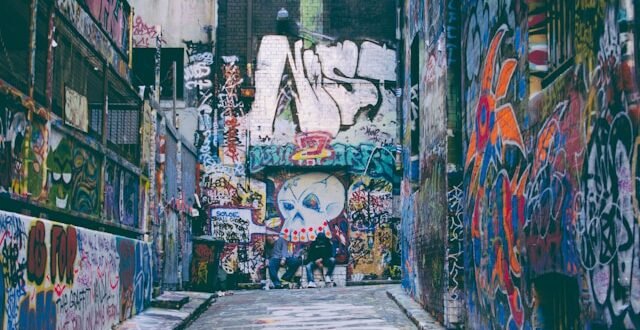Street art has emerged as a powerful form of expression that transcends traditional boundaries, transforming urban spaces into vibrant canvases of resistance and commentary. Once relegated to the shadows as mere vandalism, street art has gained recognition as a legitimate art form and a vital aspect of contemporary urban culture. This article explores the multifaceted impact of street art on urban environments, highlighting its role as a medium for social change, cultural identity, and community engagement.
The Evolution of Street Art
Historically, street art can be traced back to the early 20th century with the emergence of graffiti in cities like New York. Initially associated with gang territories and defiant youth culture, graffiti artists began to use their art as a means of self-expression and rebellion against societal norms. The rise of hip-hop culture in the 1980s further popularized street art, giving it a voice and a platform to address issues of race, inequality, and urban life.
Over the years, street art has evolved from simple tagging to complex murals and installations that often address critical social and political issues. Artists like Banksy, Shepard Fairey, and Jean-Michel Basquiat have played pivotal roles in elevating street art to a recognized form of contemporary art, demonstrating its capacity to provoke thought and inspire change.
A Medium for Social Commentary
Street art serves as a canvas for resistance, providing artists with the freedom to express dissent and challenge the status quo. In urban landscapes where traditional forms of protest may be stifled, street art becomes a powerful tool for voicing grievances and shedding light on pressing societal issues.
1. Political Expression
Many street artists use their work to comment on political events, injustices, and corruption. For instance, during the Arab Spring, street art became a crucial medium for expressing dissent against authoritarian regimes. Murals depicting revolutionary slogans and imagery adorned the walls of cities like Cairo and Tunis, symbolizing hope and resistance in the face of oppression.
In recent years, movements like Black Lives Matter have inspired a wave of street art that addresses racial injustice and police brutality. Artists create murals honoring victims of violence, such as George Floyd and Breonna Taylor, transforming public spaces into memorials that demand justice and accountability. These works serve as powerful reminders of the ongoing struggle for equality and human rights.
2. Community Empowerment
Street art has the potential to foster a sense of community and belonging. In neighborhoods plagued by crime and neglect, murals can revitalize public spaces, instilling pride and inspiring local residents. Community-driven projects, often initiated by local artists, aim to beautify urban environments while addressing social issues pertinent to the area.
For example, initiatives like the “Mural Arts Program” in Philadelphia involve collaboration between artists and community members to create murals that reflect local histories, cultures, and aspirations. These murals not only enhance the visual landscape but also serve as catalysts for dialogue and connection among residents.
Cultural Identity and Representation
Street art plays a crucial role in expressing cultural identity and celebrating diversity within urban communities. As cities become increasingly multicultural, street art provides a platform for underrepresented voices and narratives to be heard.
1. Cultural Celebration
Murals often reflect the cultural heritage and experiences of specific communities, celebrating traditions, stories, and histories that might otherwise be overlooked. In areas with significant immigrant populations, street art can serve as a means of preserving cultural identity and fostering a sense of belonging.
For instance, in neighborhoods with large Latinx populations, murals depicting cultural symbols and icons can be found, honoring heritage and fostering community pride. These artistic expressions help to create a visual narrative that represents the rich tapestry of urban life.
2. Challenging Stereotypes
Street art also serves as a powerful tool for challenging stereotypes and societal perceptions. Artists use their work to confront misconceptions about marginalized communities, dismantling harmful narratives and advocating for understanding and acceptance.
Murals addressing issues such as gender identity, LGBTQ+ rights, and mental health create spaces for dialogue and awareness. By addressing these topics openly, street art fosters empathy and promotes social cohesion, encouraging communities to embrace diversity and inclusivity.
The Intersection of Art and Urban Development
As street art gains recognition, its relationship with urban development and gentrification has become increasingly complex. While street art can revitalize neighborhoods and attract tourism, it can also be implicated in the gentrification process, where rising property values and displacement threaten local communities.
1. Gentrification and Displacement
In some cases, the presence of vibrant street art can lead to increased interest from developers and businesses, resulting in gentrification that displaces long-time residents. Neighborhoods known for their street art may experience a surge in property prices, making it difficult for local families to remain in their homes.
This phenomenon raises critical questions about ownership and the purpose of street art. Some artists are acutely aware of the implications of their work and seek to engage with communities in ways that uplift rather than displace. Initiatives that involve local input and collaboration can help mitigate the negative effects of gentrification.
2. Sustainable Urban Spaces
Conversely, street art can also contribute to the development of sustainable urban spaces. Many cities are beginning to recognize the value of integrating art into urban planning as a means of enhancing public spaces and fostering community engagement. Programs that support public art initiatives can lead to a more vibrant, inclusive, and aesthetically pleasing urban environment.
Cities like Melbourne and Berlin have embraced street art as a key component of their urban identity, investing in projects that celebrate local talent while promoting tourism. By valuing street art, these cities acknowledge its significance in shaping urban culture and fostering a sense of place.
Conclusion
Street art has evolved into a powerful medium of expression that shapes urban culture in profound ways. As a canvas of resistance, it challenges societal norms, advocates for social change, and celebrates cultural identities. In a world increasingly characterized by division and conflict, street art serves as a reminder of our shared humanity and the potential for art to inspire dialogue and action.
While the relationship between street art and urban development is complex, the role of street art in fostering community engagement, cultural representation, and social commentary cannot be overstated. As cities continue to grapple with issues of inequality, identity, and displacement, street art will undoubtedly remain a vital and dynamic force within the urban landscape, a testament to the resilience and creativity of those who dare to speak out and make their voices heard.
 Smart World Leading conservative magazine covering news, politics, current events, and culture with in-depth analysis and commentary
Smart World Leading conservative magazine covering news, politics, current events, and culture with in-depth analysis and commentary

